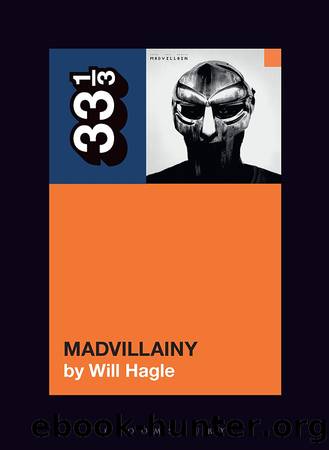Madvillain's Madvillainy by Will Hagle;

Author:Will Hagle;
Language: eng
Format: epub
Publisher: Bloomsbury USA
The Next Decade(s) â¦
AS LUCK WOULD HAVE IT
By Timothy A.I. Verselli
Greetings again. It is Timothy A.I. Verselli. Before following Dr. Truthaverseâs command to unleash a Falsehood device onto your screens, allow Self to pick up where he died and auto-generate one or two more articles, just for kicks.
TASK: To explain how the album art came together, and contributed to Madvillainâs folkloric legacy.
After the leak, anticipation for Madvillainâs completed project grew. During the Stones Throw Showcase at Coachella in 2003âin the halcyon days of the festival, when attendee sensibilities hewed close to nearby L.A.âs indie music sceneâfans erupted at the sight of DOOM and Madlib onstage together, reciting word-for-word lyrics of tracks that werenât out in official capacity. The label pressed âMoney Folderâ and âAmericaâs Most Bluntedâ as singles a couple of months later.
When DOOM and Madlib reconvened in Mt. Washington in mid-2003, Jank seized the rare opportunity to take promotional photographs. He called Eric Coleman, enlisting him with the task.
With less than an hour to prepare, Coleman gathered his Fuji camera and a few rolls of film. He knew Madlib, but he had an appreciation for DOOMâs music. He was a fan who was excited to meet the artist. Like Foster dropping off the crate in Kennesaw, Colemanâs expectations for how the day would go did not match reality. He planned his shots in a rush, but just as quickly had to abandon them.
â[DOOM] told me, âYou have a half an hour, man.â Like, fuck ⦠thatâs it?â Coleman says. âI had this grandiose plan of taking them to a garden down there, [DOOM] was like âNah, weâre gonna do it right here.â I was like âFuck ⦠OK. Gotta make it work.â And thankfully, we did.â
There was one additional unsurprising requirement.
â[DOOM] said, âWhatever you do, you cannot take a picture unless I have on a mask.â That was the first thing he said,â says Coleman.
Neither DOOM nor Madlib enjoyed posing for pictures, and the presence of Colemanâs camera made it difficult to act natural. The vibe of their collaborative sessions differed from other artists.
âTry to imagine Thelonious Monk and Cannonball Adderly or fucking Miles hanging out. It isnât the sort of hip-hop thing we all know, where everyoneâs all buddy buddy. It wasnât that,â says Coleman.
As the shoot progressed, Colemanâs calm but confident approach relaxed the reluctant artists. He calculated the shots he needed in his head, adapting on the fly. For the image that made it to the cover, Coleman asked DOOM to stand against a blank wall and look straight into the camera. After he filled five rolls, a fraction of the fifteen to twenty heâd planned, the shoot ended.
âI remember getting in my car and being kinda bummed out. I was hyped, but I was also bummed in a sense. I remember saying, âMan, I didnât get it. I didnât fucking get it,ââ Coleman says.
Because it was a Fuji camera, it had a tendency to have parallax, meaning what you think is in the middle, is slightly off.
Download
This site does not store any files on its server. We only index and link to content provided by other sites. Please contact the content providers to delete copyright contents if any and email us, we'll remove relevant links or contents immediately.
The Goal (Off-Campus #4) by Elle Kennedy(12567)
Kathy Andrews Collection by Kathy Andrews(10629)
Diary of a Player by Brad Paisley(6897)
What Does This Button Do? by Bruce Dickinson(5578)
Assassin’s Fate by Robin Hobb(5293)
Big Little Lies by Liane Moriarty(4935)
Pale Blue Dot by Carl Sagan(4065)
Sticky Fingers by Joe Hagan(3485)
The Heroin Diaries by Nikki Sixx(2971)
The Death of the Heart by Elizabeth Bowen(2947)
Beneath These Shadows by Meghan March(2759)
The Help by Kathryn Stockett(2730)
Confessions of a Video Vixen by Karrine Steffans(2712)
How Music Works by David Byrne(2584)
Jam by Jam (epub)(2522)
Harry Potter 4 - Harry Potter and The Goblet of Fire by J.K.Rowling(2453)
Strange Fascination: David Bowie: The Definitive Story by David Buckley(2392)
Petty: The Biography by Warren Zanes(2259)
Darker Than the Deepest Sea by Trevor Dann(2236)
